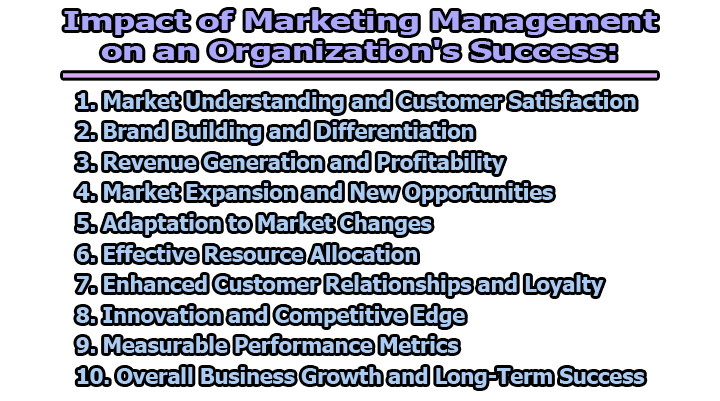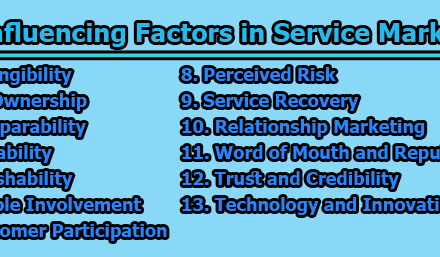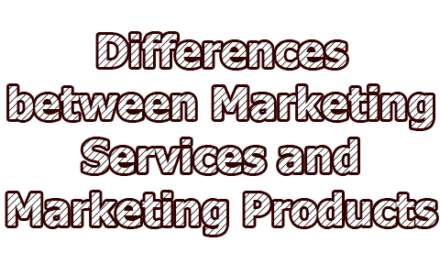Impact of Marketing Management on an Organization’s Success:
The impact of marketing management on an organization’s success is profound, influencing various aspects that contribute to sustainable growth and profitability. Here are key ways in which marketing management can positively affect an organization:
1. Market Understanding and Customer Satisfaction: Marketing management begins with a thorough understanding of the market, including customer needs, preferences, and behaviors. Through market research, organizations gain insights into their target audience, helping them tailor their products or services to meet specific demands. By aligning offerings with customer expectations, businesses can enhance customer satisfaction, which is crucial for building loyalty and positive brand perception.
Example: If a cosmetics company identifies a growing trend in consumer preference for cruelty-free and sustainable beauty products, marketing management strategies may involve introducing such products to align with these values, ultimately satisfying customer demands.
2. Brand Building and Differentiation: Marketing management plays a pivotal role in brand building, which involves creating a distinct identity for the organization in the minds of consumers. Consistent messaging, visual elements, and positive customer experiences contribute to brand differentiation. A well-established brand not only attracts customers but also provides a competitive advantage by setting the organization apart from competitors.
Example: Apple’s marketing management has led to the creation of a strong brand associated with innovation, sleek design, and user-friendly technology. This differentiation has allowed Apple to command premium prices and build a dedicated customer base.
3. Revenue Generation and Profitability: One of the primary goals of marketing management is to drive sales and revenue. Through effective marketing strategies, such as targeted advertising, pricing optimization, and strategic partnerships, organizations can increase the demand for their products or services. This, in turn, contributes directly to the organization’s financial success and overall profitability.
Example: During promotional events like Black Friday, marketing management strategies may include aggressive pricing, limited-time offers, and extensive advertising to stimulate sales and boost revenue for retailers.
4. Market Expansion and New Opportunities: Marketing management identifies opportunities for market expansion and diversification. By analyzing market trends and consumer behavior, organizations can explore new customer segments or geographic markets. This strategic growth contributes to the overall success of the business by tapping into untapped markets and reducing dependence on a single customer base.
Example: A software company that traditionally targeted small businesses may identify an opportunity to expand into the enterprise market by developing scalable solutions tailored to the needs of larger organizations.
5. Adaptation to Market Changes: Markets are dynamic and subject to constant changes in consumer preferences, technological advancements, and competitive landscapes. Marketing management enables organizations to stay agile and responsive to these changes. By monitoring market trends and conducting regular environmental scans, businesses can adapt their strategies, ensuring continued relevance and success.
Example: The rise of e-commerce has prompted traditional retailers to adapt their marketing strategies to establish an online presence, offer convenient digital shopping experiences, and compete effectively in the changing retail landscape.
6. Effective Resource Allocation: Marketing management involves strategic planning and resource allocation, ensuring that budgets are optimized for maximum impact. By analyzing the effectiveness of various marketing channels and initiatives, organizations can allocate resources efficiently. This includes budgeting for advertising, promotions, distribution, and other activities, ensuring that investments align with overall marketing objectives.
Example: A marketing manager may analyze the return on investment (ROI) for different advertising channels and decide to allocate a larger portion of the budget to online marketing if it consistently generates higher returns compared to traditional media.
7. Enhanced Customer Relationships and Loyalty: Marketing efforts, especially those focused on relationship-building, contribute to customer loyalty. Effective communication, personalized experiences, and loyalty programs foster long-term relationships. A loyal customer base not only generates repeat business but also becomes a valuable asset in terms of positive word-of-mouth marketing and advocacy.
Example: A coffee shop may implement a customer loyalty program, offering rewards and discounts to frequent customers. This not only encourages repeat visits but also strengthens the emotional connection between the brand and its customers.
8. Innovation and Competitive Edge: Marketing management encourages innovation by identifying market trends and emerging customer needs. Organizations that invest in research and development based on market insights can introduce innovative products or services. This innovative approach provides a competitive edge, allowing the organization to stay ahead in the market.
Example: Smartphone manufacturers regularly introduce new features and technologies based on market trends and consumer preferences, aiming to differentiate their products and maintain a competitive edge in the fast-paced tech industry.
9. Measurable Performance Metrics: Marketing management involves setting measurable objectives and key performance indicators (KPIs). Regular evaluation of these metrics allows organizations to track the effectiveness of their marketing strategies. Data-driven decision-making ensures that marketing efforts are aligned with organizational goals, and adjustments can be made based on real-time performance data.
Example: An e-commerce platform may set KPIs such as conversion rates, click-through rates, and customer acquisition costs to measure the effectiveness of online advertising campaigns, allowing for continuous optimization.
10. Overall Business Growth and Long-Term Success: The cumulative impact of effective marketing management on customer acquisition, retention, brand equity, and financial performance contributes to overall business growth. A well-executed marketing strategy sets the foundation for sustained profitability and organizational resilience, ensuring long-term success in a competitive business environment.
Example: A global technology company’s successful marketing management, involving strategic product launches, effective branding, and customer-centric campaigns, contributes to its consistent growth and market leadership over the years.
In conclusion, marketing management is a crucial function that permeates various aspects of an organization, influencing its reputation, customer relationships, and financial performance. A strategic and well-executed marketing approach is integral to achieving and sustaining success in today’s competitive business environment.

Former Student at Rajshahi University










